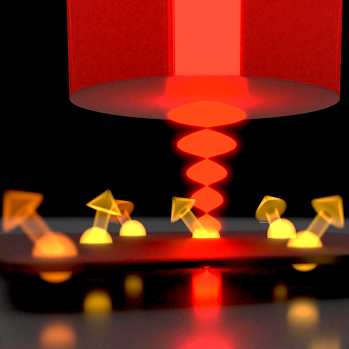Spin-photon interface for single rare earth ions


Rare earth ions provide exceptional optical and hyperfine coherence, which makes them promising candidates for quantum information applications, ranging from quantum memories and quantum computing nodes to quantum-nonlinear optics. However, the dipole-forbidden nature of the narrow transitions results in ultra-low emission rates, limiting most experiments to macroscopic ensembles. We want to gain efficient access to individual ions and small ensembles by coupling them to a high finesse optical microcavity. Purcell enhancement can boost the emission rate by several orders of magnitude, thereby making the weak transitions bright and enabling efficient state readout. We use microcavities based on laser-machined optical fibers as mirror substrates, which combine high finesse with small mode cross sections and full tunability.
The fiber-opposing planar mirror incorporates the rare-earth ion doped nanocrystals in the cavity (Fig.1). Addressing of individual ions is achieved in the spectral domain via a stabilized, narrowband laser. This scheme makes use of the large ratio between the broad inhomogeneous crystal linewidth versus a narrow homogeneous single ion linewidth (Fig.2) opening up the possibility to have efficient access to possibly thousands of qubits contained in one cavity mode.
As a first step, we have performed cavity-enhanced fluorescence spectroscopy of individual nanocrystals, allowing the detection of signals from small ensembles of about 10 Europium ions [Casabone et al.]. We were able to demonstrate multi-modal Purcell enhancement and to measure the homogeneous linewidth of small ensembles within a single nanoparticle [Eichhorn et al. 2024]. Within a collaboration with Hugues de Riedmatten, this approach could be used to demonstrate strong and dynamically switchable Purcell enhancement of Erbium ions in a nanocrystal [Casabone 2020]. Harnessing emission enhancement by up to hundred-fold, also single Erbium ions with narrow linewidths could be observed [Deshmukh et al. 2023].
Molecular lanthanide complexes
Recently, we started to study molecular complexes based on Europium which show remarkable optical coherence and long-lived nuclear spin states [Serrano 2022, Kuppusamy 2023 Schlittenhardt 2024, Kuppusamy 2024]. Synthetic chemistry opens up the possibility to tailor the optical and spin properties, such that optimized photon emission and spin coherence can be specifically targeted. Furthermore, molecules can be arranged in regular arrays such as molecular crystals or supra-molecular assemblies, e.g. via self-assembly. This opens up the perspective for the controlled realization of scalable qubit registers.

